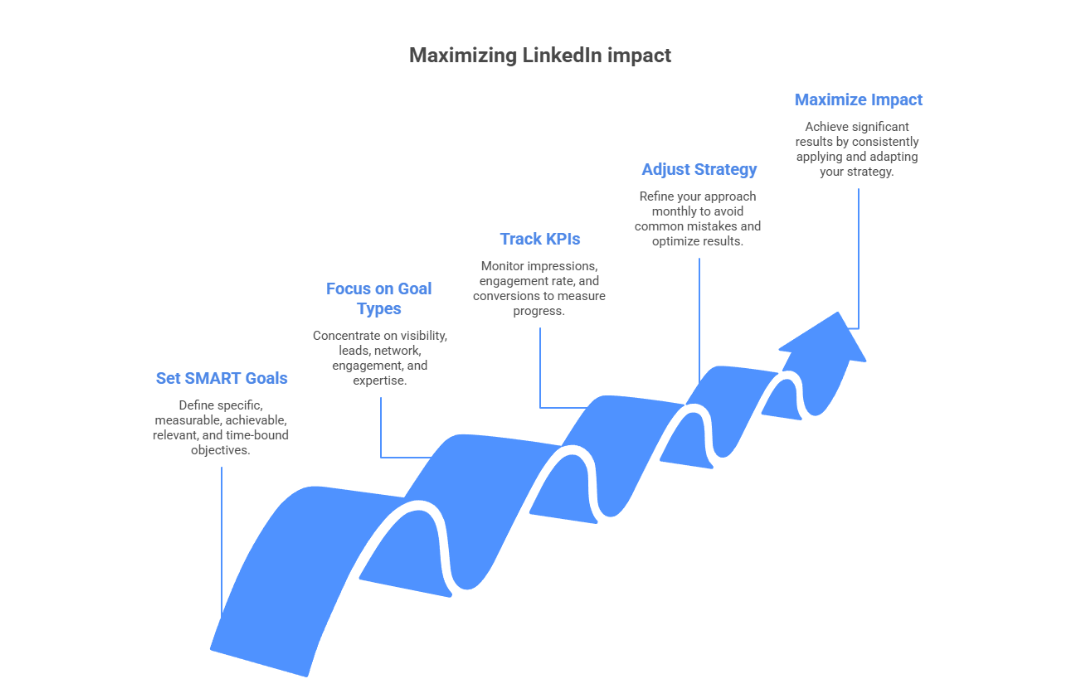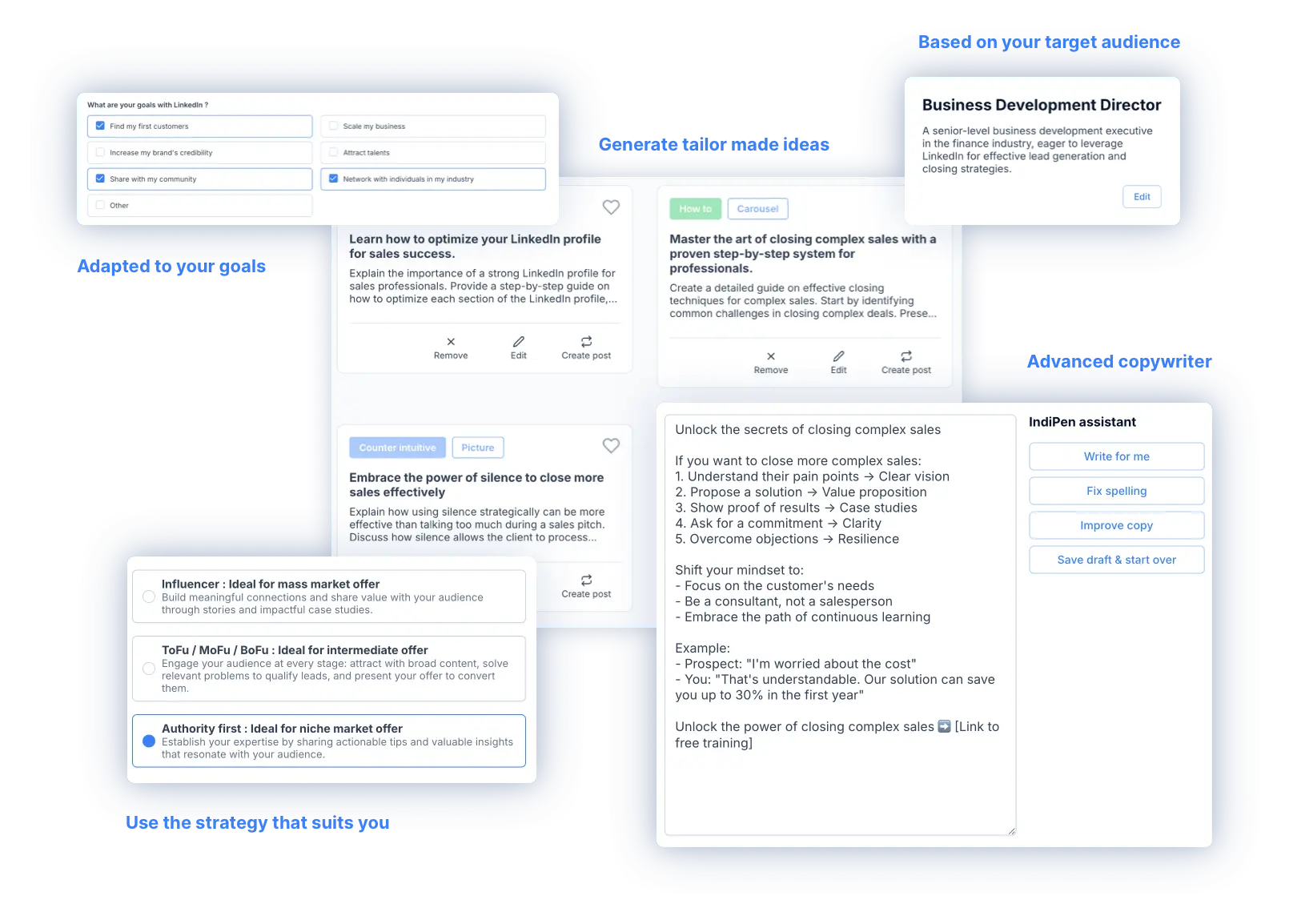How to define clear objectives for your LinkedIn strategy?
Why is setting precise objectives on LinkedIn crucial?
In the ocean of LinkedIn content, many professionals post randomly hoping that “something” will work.
Spoiler alert: this approach doesn’t work…
To succeed on LinkedIn, you need a solid LinkedIn strategy with clear objectives from the start. Without defined objectives, it’s like navigating without a compass: you move, but you don’t know if you’re going in the right direction.
In this article, I’ll show you how to define precise objectives that will transform your LinkedIn presence into a results machine. No more time wasted on actions without impact!
Why are objectives essential for your LinkedIn strategy?
The problem of lacking objectives
Without clear objectives, you find yourself in these situations:
- You scatter yourself: you post on all topics without coherence.
- You lose your motivation: without visible results, you give up quickly.
- You waste your time: you invest hours without return on investment.
- You measure everything and nothing: you look at your stats without knowing what really counts.
The benefits of well-defined objectives
With precise objectives, you get:
- Clear direction: every action has a purpose.
- Measurable results: you know exactly where you stand.
- Constant motivation: you see your progress regularly.
- Return on investment: your LinkedIn time becomes profitable.
The SMART method adapted to LinkedIn
What is the SMART method?
With the SMART method, your ambitions take shape and become precise steps:
- Specific: your objective is clear and precise.
- Measurable: you can track your progress with numbers.
- Achievable: it’s realistic with your resources.
- Relevant: it corresponds to your business priorities.
- Time-bound: you have a precise deadline.
Examples of SMART objectives for LinkedIn
❌ Vague objective: “Increase my visibility on LinkedIn.”
✅ SMART objective: “Increase my post views by 50% (from 1000 to 1500 average views) by posting 4 posts per week for 2 months.”
❌ Vague objective: “Develop my network.”
✅ SMART objective: “Add 100 new qualified contacts in my sector (digital marketing) within 3 months, with a 70% acceptance rate.”
The 5 essential types of objectives for LinkedIn
1. Visibility and brand awareness objectives
These objectives allow you to be seen and recognized in your sector.
Concrete examples:
- Increase your followers by 30% in 3 months.
- Reach 2000 average views per post within 6 months.
- Post on LinkedIn 3 times per week consistently using the best days and times to publish.
Formats to maximize visibility:
- Text posts with strong hooks and captivating LinkedIn headlines
- Carousels that generate leads with educational content
- Video content to humanize your brand
- Types of posts that generate engagement
2. Lead generation objectives
Transform LinkedIn into a qualified prospects machine.
Concrete examples:
- Generate 20 new qualified prospects per month.
- Increase your message response rate from 15% to 25%.
- Convert 10% of your new connections into discovery calls through effective LinkedIn prospecting.
Strategies for lead generation:
- Understand why you need to add prospects on LinkedIn before starting
- Learn how to add prospects on LinkedIn effectively
- Master social selling on LinkedIn techniques
3. Network development objectives
Build a quality professional network.
Concrete examples:
- Add 50 new qualified contacts per month.
- Join 5 relevant LinkedIn groups in your sector.
- Participate in 20 group discussions each week.
Effective strategies:
- Use LinkedIn groups to generate qualified leads
- Comment on LinkedIn posts from creators in your sector
- Apply social selling techniques to build meaningful relationships
4. Engagement and interaction objectives
Create an active community around your content.
Concrete examples:
- Achieve a 5% engagement rate on your posts.
- Receive 50 comments per post on average.
- Create 10 discussions per month in comments.
Formats that generate engagement:
- Open questions: “What is your opinion on…?”
- Controversial posts (with tact): take a stand on current topics.
- Storytelling: share personal experiences to create emotional connections.
Commenting strategies:
- Learn 6 reasons to comment on LinkedIn posts
- Use 10 approaches for comments that turn engagement into leads
- Avoid common mistakes in LinkedIn comments
5. Expert positioning objectives
Become the reference in your field.
Concrete examples:
- Be mentioned in 10 other experts’ posts per month.
- Receive 5 interview or podcast requests per month.
- Have 20 shares of your content per week.
Positioning strategies:
- Publish in-depth analyses of your sector.
- Comment intelligently on influencers’ posts.
- Share your predictions and market visions.
The essential KPIs to track your LinkedIn objectives
Visibility metrics
- Impressions: number of times your content is seen.
- Reach: number of unique people who see your content.
- Follower growth: evolution of your audience.
- Profile views: interest generated by your person.
Engagement metrics
- Engagement rate = (likes + comments + shares) / impressions × 100.
- Comments per post: level of interaction with your audience.
- Mentions: number of times you’re tagged.
- Shares: virality of your content.
Lead generation metrics
- Clicks on your links: interest in your offers.
- Messages received: direct solicitations.
- Connection requests: growth of your network.
- Conversion rate: prospects transformed into clients.
Network metrics
- New connections: expansion of your network.
- Acceptance rate: quality of your connection requests.
- Group interactions: community engagement.
- Recommendations received: recognition from your peers.
How to adjust your objectives over time
The importance of flexibility
Your objectives are not set in stone. The LinkedIn algorithm evolves, your business changes, your priorities too. You must adapt your objectives regularly.
Warning signals that require adjustment:
- Results stagnation: same numbers for 3 months.
- Algorithm change: sudden drop in reach.
- Business evolution: new commercial objectives.
- Market saturation: increased competition.
Monthly revision method
- Analyze your KPIs: compare with the previous month.
- Identify gaps: where are you compared to your objectives?
- Look for causes: why these results?
- Adjust your strategy: what will you change next month?
- Redefine your objectives: are they still relevant?

Common mistakes to avoid in objective definition
- Objectives that are too ambitious: wanting to go from 100 to 10,000 followers in 1 month is unrealistic. Start small and progress gradually.
- Focusing only on vanity metrics: likes and followers are good. Qualified leads and clients are better. Focus on what impacts your business.
- Objectives not aligned with your business: if you sell B2B, generating engagement from the general public won’t bring you clients. Define your persona first to target the right audience.
- Neglecting profile optimization: having ambitious objectives with a non-optimized LinkedIn profile is like wanting to run a marathon in flip-flops. Learn how to optimize your LinkedIn profile and boost your LinkedIn profile visibility. Don’t forget to optimize your cover picture too.
Additional mistakes to avoid:
Check our comprehensive guide on 5 mistakes to avoid in your LinkedIn strategy for more insights.
Concrete action plan to define your LinkedIn objectives
Step 1: Audit your current situation
- Analyze your KPIs from the last 3 months.
- Identify your strengths and weaknesses.
- Evaluate the quality of your profile using our profile optimization guide.
Step 2: Define your SMART objectives
- Choose 3 objectives maximum (focus = efficiency).
- Apply the SMART method to each one.
- Ensure they are aligned with your business and defined persona.
Step 3: Choose your tracking KPIs
- Select 2-3 metrics per objective.
- Set up a simple dashboard.
- Schedule weekly checkpoints.
Step 4: Create your content plan
- Define your priority formats using our 10 types of LinkedIn posts guide.
- Establish a publication calendar with optimal posting times.
- Prepare your first content incorporating storytelling techniques.
Step 5: Launch and track
- Start immediately (no perfectionism).
- Adjust based on first results.
- Celebrate your victories, even small ones.
Conclusion: From strategy to action
Defining clear objectives for your LinkedIn strategy means transforming your profile into a results machine. With the SMART method, relevant KPIs, and a well-optimized profile, you go from amateur to professional status.
The essentials to remember:
- Start with 1 SMART objective for 30 days.
- Measure 2-3 KPIs maximum per objective.
- Adjust each month based on results.
The secret is not to have perfect objectives, but to start and adjust intelligently. Make sure to avoid the common LinkedIn strategy mistakes and focus on building genuine relationships through effective social selling and prospecting techniques.
FAQ: LinkedIn objectives
How often should I revise my LinkedIn objectives?
Revise your objectives each month for minor adjustments and every 3 months for major revisions. This allows you to stay agile while keeping on track.
How many LinkedIn objectives can I have simultaneously?
Focus on 3 objectives maximum. The more you have, the more you risk scattering yourself and accomplishing nothing correctly.
How do I know if my LinkedIn objectives are realistic?
Your objectives are realistic if you can achieve them by dedicating 30–60 minutes per day with your current resources. Start small and increase gradually.
What should I do if I don’t reach my LinkedIn objectives?
Analyze the causes: lack of time, too ambitious objectives, bad strategy? Adjust accordingly rather than giving up. Consider reviewing our guide on LinkedIn strategy mistakes to identify potential issues.
Should I have the same objectives as a competitor?
No! Your objectives must correspond to YOUR business, YOUR resources and YOUR situation. Get inspired by others but adapt to your context based on your defined persona.
How to measure qualitative objectives like “improve my reputation”?
Transform the qualitative into quantitative: number of positive mentions, recommendations received, event invitations, etc.
Should I share my LinkedIn objectives publicly?
It’s personal, but sharing your objectives can create an engagement effect and help you stay motivated. Test what works for you using effective storytelling techniques.
Ready to turn your LinkedIn profile into a Lead Machine ?
IndiPen helps you define your strategy, find content idea and write engaging content to generate leads with ease
Book a demo
